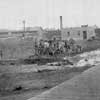Feature Article
REAL-ESTATE COLLAPSE LEFT RED DEER NEAR BANKRUPT: 1921
Written By: Michael Dawe
Published By: Red Deer Advocate Centennial Book
Article Used with permission. © Copyright Michael Dawe and the Red Deer Advocate, 2007
2007-01-01

In November 1921, the Calgary-Edmonton Townsite Co. offered to turn over all of their property in Red Deer to the city in order to clear up the tens of thousands of dollars of taxes owing on the company’s holdings.
The company’s legal and financial agents, Osler, Hammond and Nanton, had decided that it was no longer worthwhile to try and put up money to cover its existing tax bill, let alone to pay down the tax arrears.
This move was of huge significance to the city. The company’s properties were so extensive that they made up eight per cent of the total assessment in the community.
In November, 1890, when the townsite of Red Deer was first created, the company literally owned half the town.
A deal had been struck with Rev. Leonard Gaetz, who had homesteaded what is now downtown Red Deer, whereby the C&E; Railroad Co. acquired a 50-per-cent share of the Gaetz farm in return for running its new rail line and locating its new rail yards on the Gaetz property.
It was a wonderful deal for both sides.
As lots were sold in the new townsite, half the proceeds went to Gaetz and the other half went to the railroad company’s subsidiary, the C&E; Townsite Co.
Initially, land sales were brisk.
However, a sharp economic depression through much of the 1890s resulted in sales slowing to a mere trickle.
During this lull, in order to simplify matters, title to some of the property was transferred directly into the name of the C&E; Townsite Co., while other pieces of land were put into the name of Leonard Gaetz and his family.
The economic situation across Canada changed dramatically at the turn of the last century after the discovery of gold in the Klondike.
Red Deer began to grow dramatically. The population of the town leapt from a mere 323 in 1901 to almost 3,000 by 1912.
The company began receiving wonderful profits on the sales of its lots.
The value placed on its remaining properties soared to almost unbelievable levels.
It is hard to exaggerate the scale of the great real estate boom. People felt that since Red Deer had grown so rapidly in the first decade of the century, it would grow even more enormously in the next decade.
Many people were sure that Red Deer would be a city of 30,000 or more by the early 1920s.
A great many new subdivisions were created, several of which were located well beyond the town limits.
Some were even beyond the current (2007) city limits of Red Deer.
A great many of those who bought and sold the lots soon considered themselves millionaires, at least on paper.
As inevitably happens with wild sprees of speculation, eventually the astonishing real estate boom came to a crashing end.
The boom started to break during 1913 when the general economy began to slow.
Many started to realize that the predictions of ever-escalating growth were fancy, not fact.
The outbreak of the First World War in 1914 caused a huge collapse in the financial markets and ended forever any hopes that the great boom would soon return.
As property values began to plunge, many of those who speculated in land decided there was no point in paying the taxes on their properties anymore.
In the summer of 1917, the City of Red Deer reported that it had seized 2,761 lots for non-payment of taxes.
In the following years, the tax defaults and land seizures grew even larger.
By the early 1920s, the city owned almost all the undeveloped land in the community.
Attempts to sell the lots for the amount of taxes owing, plus costs, failed.
With so much land on the market, most of the properties became virtually worthless.
The city then began the process of cancelling several of the subdivisions.
At the same time that it announced the takeover of the C&E; Townsite Co. properties, it announced that it was canceling subdivisions contained 2,000 lots.
All the defaults on taxes and subsequent seizures of near worthless land left the City of Red Deer virtually bankrupt.
However, while many years of financial hardship followed for the city, there was a silver lining to the crisis.
When good times finally returned, albeit more than two decades later, the city had a massive amount of land on hand for sale to new businesses and people wishing to build new homes in the community.
As the old lots were sold off, the city wisely decided to invest a good portion of the proceeds in the purchase of new parcels of land, which could then be developed as city-owned subdivisions. The city’s highly successful land-bank system developed, which helped the city enormously as it dealt with new growth and new prosperity.
This article was written by Michael Dawe for the Red Deer Advocate’s Centennial Book. The Heritage Community Foundation would like to thank Michael Dawe and the Red Deer Advocate for permission to reprint these materials online. Please visit the Red Deer Advocate online.The images in the article are part of the collection of the Red Deer Archives. Please visit them online.



